I’ve given up trying to chronicle everything as it is happening at the conference – there’s just too much going on. If you’re a fan of the Space Elevator, this conference is truly “red meat” (unless you’re a vegetarian, of course, in which this conference is truly “red beans” 🙂 )…
Seriously, the quantity and quality of the content today was very high, exceeding even my lofty expectations. The conference venue is also superb – the Microsoft Conference center is one of the best I’ve ever been at. Every place to sit has desk space, outlets, access to excellent wireless network, etc. It allows you to concentrate on the conferece proceedings, which is the way it should be…
Earlier today, I tried to chronicle things as they were happening, but it was causing me to miss too much of the Conference’s content. So, I’m going to put up a few more posts now of some of the days highlights. It’s probably all I will be able to manage tomorrow, too. However, I now have lots of blogging material for the next week or two, so expect a barrage of Conference reports in the near future.
So, some miscellaneous notes from today before I return to covering some of the presentations…
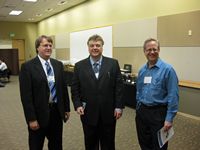 One of the great things about being involved in the Space Elevator effort is all of the wonderful people I’ve been able to meet. Three of them are in this picture. From left to right, they are Bryan Laubscher, Martin Lades and Alan Boyle. Bryan and Martin are the conference chairs and organizers (along with a few others who I will mention later on). Bryan and Martin were also on the Space Show a few days ago, discussing the then upcoming conference (an event I chronicled here). Alan, of course, is the Science Editor at MSNBC.com and the editor/owner of the Cosmic Log. He’s a great journalist, the owner of numerous awards, is wonderful to work with and already has an excellent post up on his Cosmic Log about the conference.
One of the great things about being involved in the Space Elevator effort is all of the wonderful people I’ve been able to meet. Three of them are in this picture. From left to right, they are Bryan Laubscher, Martin Lades and Alan Boyle. Bryan and Martin are the conference chairs and organizers (along with a few others who I will mention later on). Bryan and Martin were also on the Space Show a few days ago, discussing the then upcoming conference (an event I chronicled here). Alan, of course, is the Science Editor at MSNBC.com and the editor/owner of the Cosmic Log. He’s a great journalist, the owner of numerous awards, is wonderful to work with and already has an excellent post up on his Cosmic Log about the conference.
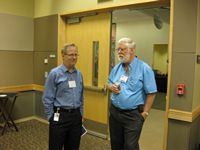 This is another picture of Alan along with Peter Swan (on the right), my co-chair of the Social/PR pillar. More about the pillars tomorrow, when we actually start the Pillar sessions.
This is another picture of Alan along with Peter Swan (on the right), my co-chair of the Social/PR pillar. More about the pillars tomorrow, when we actually start the Pillar sessions.
.
.
 And here is a picture of Ben Shelef of the Spaceward foundation (on the left) and Andy Price. Andy sends out “email nuggets” regarding carbon nanotube developments – interesting stuff that I often blog about. Can you tell that they have slightly different heights? 🙂
And here is a picture of Ben Shelef of the Spaceward foundation (on the left) and Andy Price. Andy sends out “email nuggets” regarding carbon nanotube developments – interesting stuff that I often blog about. Can you tell that they have slightly different heights? 🙂
.
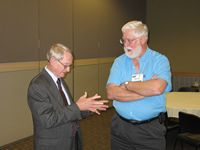 Finally, here is a picture of Peter Swan and, on the left, Jerome Pearson, one of the inventors of the Space Elevator (along with Yuri Artsutanov) and a presenter in a couple of sessions today (more on these later). It was a real thrill for me to be able to meet Mr. Pearson today. If we can ever get a Space Elevator to work, humanity will owe a great debt to him and Mr. Artsutanov.
Finally, here is a picture of Peter Swan and, on the left, Jerome Pearson, one of the inventors of the Space Elevator (along with Yuri Artsutanov) and a presenter in a couple of sessions today (more on these later). It was a real thrill for me to be able to meet Mr. Pearson today. If we can ever get a Space Elevator to work, humanity will owe a great debt to him and Mr. Artsutanov.

 We have a large Japanese presence at the conference this year, and they have made a tremendous contribution to the proceedings. In addition, to making several presentations (and some very exciting announcements), they have brought an exhibit, a DVD we all watched during the “Mixer” hour this evening and probably a few other things I’m forgetting to mention. They even brought some gifts for yours truly, some Pocky for my kids and a copy of the Edwards-Westing book translated into Japanese (a book I
We have a large Japanese presence at the conference this year, and they have made a tremendous contribution to the proceedings. In addition, to making several presentations (and some very exciting announcements), they have brought an exhibit, a DVD we all watched during the “Mixer” hour this evening and probably a few other things I’m forgetting to mention. They even brought some gifts for yours truly, some Pocky for my kids and a copy of the Edwards-Westing book translated into Japanese (a book I 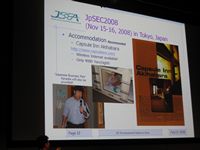
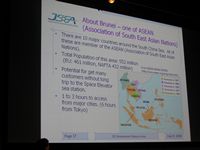
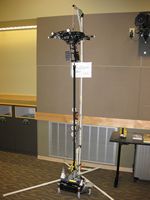






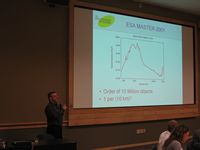 In this picture, however, Ben is responding to a presentaton given earlier by Ivan Bekey, highlighting potential problems to the Space Elevator, this case space debris. Ben is pointing out that the problem is not as bad as feared; the great majority of debris is so small that it’s damage to the elevator is ‘manageable’, while the larger objects are so infrequent that moving the elevator can take care of it.
In this picture, however, Ben is responding to a presentaton given earlier by Ivan Bekey, highlighting potential problems to the Space Elevator, this case space debris. Ben is pointing out that the problem is not as bad as feared; the great majority of debris is so small that it’s damage to the elevator is ‘manageable’, while the larger objects are so infrequent that moving the elevator can take care of it.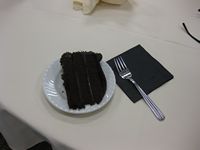 Mmmm, chocolate fudge cake. A note that Randy Lieberman (who spoke earlier) was responsible for the delicious lunch today. Thanks Randy!
Mmmm, chocolate fudge cake. A note that Randy Lieberman (who spoke earlier) was responsible for the delicious lunch today. Thanks Randy!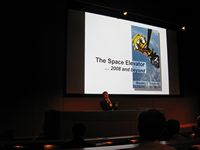
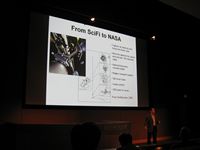
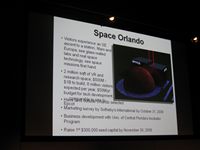
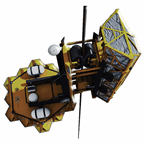 Here we go. It’s now 9:10 am, Pacific time, and the 2008 Space Elevator Conference is underway.
Here we go. It’s now 9:10 am, Pacific time, and the 2008 Space Elevator Conference is underway.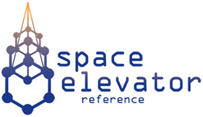 Over at the Space Elevator Reference website, Marc Boucher
Over at the Space Elevator Reference website, Marc Boucher  Only two more days until the 2008
Only two more days until the 2008 
 Several days ago, I put up a
Several days ago, I put up a  A
A  Remember, on today’s ‘The Space Show’, host Dr. David Livingston interviews Dr.’s Bryan Laubscher and Martin Lades to talk about the upcoming Space Elevator Conference and the ‘state of affairs’ for the Space Elevator.
Remember, on today’s ‘The Space Show’, host Dr. David Livingston interviews Dr.’s Bryan Laubscher and Martin Lades to talk about the upcoming Space Elevator Conference and the ‘state of affairs’ for the Space Elevator. This is cool. The Discovery Channel has put together a select
This is cool. The Discovery Channel has put together a select  A couple of months ago, we heard the “Mobile Home Astrophysicist’s”
A couple of months ago, we heard the “Mobile Home Astrophysicist’s” 
 At KansasCity.com, author Jonathan Bender wrote an
At KansasCity.com, author Jonathan Bender wrote an  Brian Turner of the
Brian Turner of the 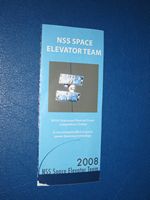

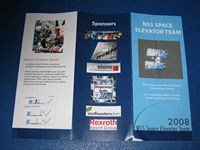

 I enjoyed attending this year’s
I enjoyed attending this year’s 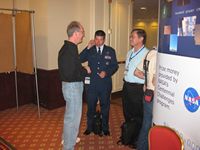
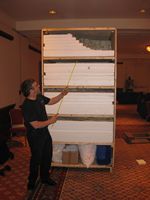
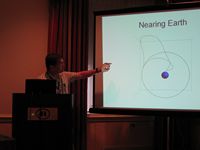
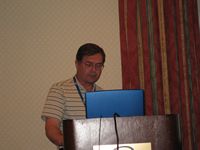
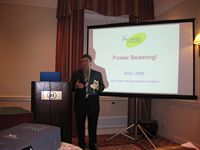
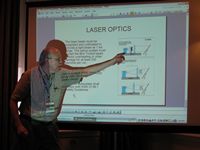



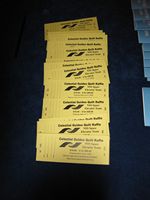


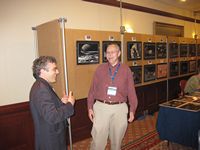
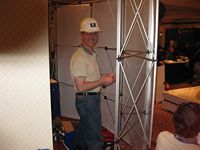

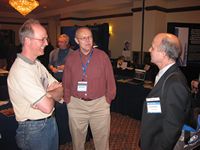
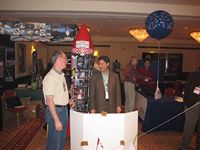
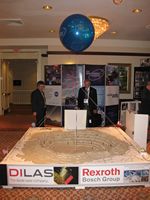
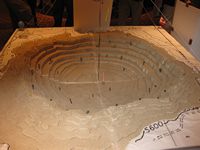
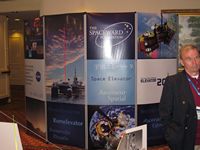
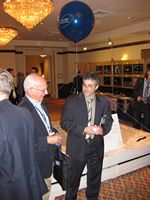


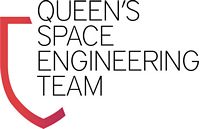 On the Queen’s Space Engineering Team
On the Queen’s Space Engineering Team  If you go to the
If you go to the 

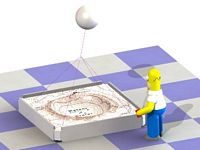


 Dr. Brad Edwards, the ‘father’ of the modern-day conception of the Space Elevator, has written a very interesting article in the latest issue of the TRUMPF newsletter (available
Dr. Brad Edwards, the ‘father’ of the modern-day conception of the Space Elevator, has written a very interesting article in the latest issue of the TRUMPF newsletter (available 
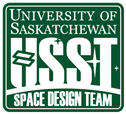 As has been
As has been 
 We have a new competitor into this year’s Climber/Power-Beaming event,
We have a new competitor into this year’s Climber/Power-Beaming event, 